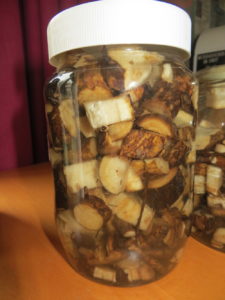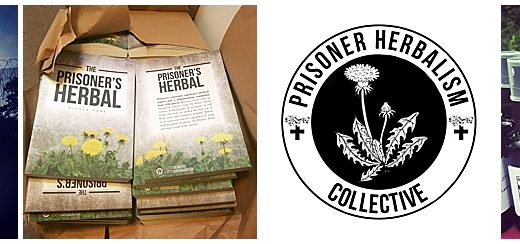Please note these plant profiles are a work in progress. I will always be adding to them as I keep learning about the amazing world of plant medicine.
Botanical Overview
Latin name: Arctium lappa (Greater Burdock), Arctium minor (Lesser Burdock)
Plant family: Asteraceae (daisy family)
Identification:
- Lesser Burdock: The lower leaves are large, heart-shaped, longer than wide with pointed tips and untoothed or with small, widely-spaced teeth along their edges. They are thick and tough but their surfaces have a rather soft texture (very short, soft hairs). Lower leaves are thick, furrowed stalks up to 30cm long. Leaves on the stems are smaller and more oval-shaped, with shorter stalks. Main stems are thick, branched and can grow over 1m tall: in summer [in the second year] they have dense, roundish, green-purple flower heads up to 3cm long, becoming brown fruiting heads in autumn, both flowers and fruits have bristles whose hooked tips catch on our clothing (1).
- Greater Burdock: Has leaves as wide as they are long with greyer undersides and solid stalks (hollow in Lesser Burdocks).
Other species: It can be mistaken for Broad Leaved Dock (Rumex obtusifolius)
Folk names in English: Beggar’s Buttons, Lappa, Fox’s Clote, Burrs, Cockle Buttons, Love’s Leaves, Thorny Burr, Stickers, Burseed, Harebur, Hare-lock, Batweed, Hardock, Wooly clock, Happy major, Bardana, Personata, Clotbur. ‘Arktos’ is a Greek word meaning bear, while lappa means to seize. In French the word ‘bourre’ means woolly.
Chemical constituents:
- Roots: Bitter principle, Inulin (up to 50%), Lignans, including arctigenin (a weak tumour growth inhibitor), Polyacetylenes (antibiotic0, Arctic acid, Sesquiterpenes, Amino acids, Acids (isovaleric, lauric, mystiric, caffeic, chlorogenic), Dietary fibre
- Seeds: 15-30% fixed oils, Bitter glycoside (arctiin), Chlorogenic acid
- Leaves: Arctiol, Fukinone, Taraxasterol (5)

Food and nutrition
In its first year, the stems and roots can be eaten as a vegetable. In Japan, burdock is known as gobo and is commonly eaten as a staple of many dishes. Stems have also been traditionally candied (8) Burdock root is very high in chromium, iron, magnesium, silicon and thiamine. It is also high in cobalt, dietary fibre, phosphorous, potassium, sodium, tin, vitamins A and C and zinc (3).
Ecological role
Burdock grows more on dryish neutral soils in the lowlands, in woods (especially woodland edges), hedgerows, field margins and on disturbed or waste ground (1). Burdock helps to restore minerals to topsoils.
Cultivation: Medicinal Herb Farmers, Melanie and Jeff Carpenter write that burdock are not ‘finicky’. It grows well in full sun, partial shade and full shade. It does well in damp and rock poor soils but thrives in soils rich in organic matter. They sow seeds direct in early spring (after stratification) (4).
Harvesting: Burdock roots are best harvested in the autumn of the first year (when the roots are sweeter). If grown in raised beds, the roots will be much easier to harvest – a bit like growing carrots. They simply chop then wash and dry the roots. Burdock seeds are collected in autumn when the roundheads have turned brown and no purple flowers remain. They can also be soaked overnight, washed and drained and sprouted like radish or alfalfa.
Energetics
- Temperature: Cooling (mild)
- Moisture: Moistening (short term), drying (longer term in terms of its diuretic action)
- Tissue State: Damp/stagnation, Dry/atrophy
- Taste: Gentle bitter, nutty, slightly pungent, oily, slightly sweet
Health challenges supported by Burdock
Herbal actions: Diuretic, Orexigenic (stimulates appetite), Alterative, Diaphoretic, Anti-rheumatic, Antiseptic, Depurative (blood purifier) (5)
Digestive health: Sajah writes that burdock stimulates the digestive tract, liver and gallbladder, increasing the secretion of bile, promoting better absorption of fats and oils through the small intestine. This action promotes increased assimilation of these fats and oils used for the integrity of tissues and tissue cells (2). Burdock is also a fantastic prebiotic. Sajah describes that burdock root contains some unique and valuable starches and soluble fibres which are rich in prebiotic sugars that feed the beneficial ecology of bacteria within the GI. He describes that when these beneficial bacteria are in equilibrium, they maintain the integrity of the gut wall, reduce inflammation, provide immunological support, and protection from pathogenic bacteria, as well as supporting overall proper digestion (2). Burdock can also have a slight laxative action for hard stools. Overall, burdock is useful for digestive symbiosis, leaky gut syndrome and antibiotic trauma.
Skin conditions: Sajah describes burdock’s role as an alterative: “Burdock will alter stubborn unresponsive conditions by cleansing the blood, clearing out impurities or toxins which block the sebaceous glands of the skin. Its been long used for septic skin disorders and chronic inflammatory heat states of these sebaceous glands such as acne, boils, carbuncles, abscesses, and other skin conditions like eczema and psoriasis. These types of skin conditions oftentimes point to a deeper imbalance within the metabolism, and thus the body’s ability to properly detoxify the system of metabolic waste products. While Burdock works directly on the skin from the inside-out, it is predominantly doing this through its affinities for the liver, kidneys, lymphatics and the blood itself (2).

Nervous conditions: Burdock’s affinity with the nervous system can be explained when we have a good understanding of how oil hydration aids the nervous system, in the way that the myelin sheathing which coats neutrons contains a fatty oily layer – imagine the rubber part around electric wires so that electrical signals can move quickly. Sajah says “When the overall oily hydration of the body becomes weak and deficient, we start to see a wide range of nervous system type complaints, such as anxiety, hysteria, nervousness, insomnia and just simple overall stress.” (2). I’ve noticed this lack of oils often in many poor vegan diets where there are not enough fats and oils and so this is where wild plants can come into their own in vegan nutrition.
Gout, arthritis and rheumatism: Burdock is an ally for joint health where there is a lack of fluid leading to dryness and heat. Alternatively, burdock is also used for joints where there is fluid accumulation in joints that leads to oedema, swelling and inflammatory pain. Sajah writes how “Burdock may help these conditions by first, cleansing the system of these metabolic impurities, flushing them out of the kidneys through diuresis, and regulating the fluid-to-mineral balance of the body by adjusting the volume of urine excreted.” (2)
Type 2 Diabetes: Sajah notes that burdock has about 45% inulin in the root and research has found that people with and without diabetes who ate inulin rich foods had fewer spikes in their blood sugars.
Cosmetic uses: Burdock seed oil is used daily as a strengthening, nourishing tonic to the hair follicles (especially if thinning from stress). Facial steam from burdock seed infusion helps clear blackheads and whiteheads from the face and back.
Bruises and wounds: Gabrielle Hatfield writes: “In folk medicine, burdock leaves, where are among the largest of any of our native British plants, have been used to wrap around wounds and bruises, like dock leaves. Burns too were soothed using the biggest and softest of the leaves.” (8).
Oedema and water retention: Burdock seeds have diuretic action. Sajah writes how the oils help lubricate these tissues and the mild astringency helps to increase tone and function, and allow for the eliminating waters to be moved with more ease and volume.
Fever management: Burdock seed is an aromatic diaphoretic that is useful in fever management. Sajah writes that other septic and aggressive conditions such as smallpox or measles – basically skin eruptions related with fever – are benefited from this remedy as it opens up the channels of elimination in more ways than one (liver, kidneys, skin) (2).
Lymphatic swelling: Sajah articulates that internally the root stimulates lymphatic circulation, benefiting all manner of lymphatic stagnation, swollen lymph nodes from acute infection and more serious scrofulous conditions (2).
Cancer: Donald Yance writes that Burdock exhibits marked anti-tumour activity and there have been some studies that show that it actually helps chemotherapies work more productively (6). Sajah articulates that it’s affinity for the liver, blood and lymphatics alone points to a systemic effect that can benefit literally any organ or tissue afflicted by cancer, as well as helping to maintain appetite, digestion, and absorption of nutrients during conventional cancer treatments like chemotherapy and radiation (2). Herbalist Hildegard of Bingen used burdock on cancer patients in the 1100s.
 Cautions: There are no major contraindications, however, it is best to be introduced slowly, especially in skin cases. It does have a mild hypoglycemic action and therefore should be used with some caution with hypoglycaemic drugs.
Cautions: There are no major contraindications, however, it is best to be introduced slowly, especially in skin cases. It does have a mild hypoglycemic action and therefore should be used with some caution with hypoglycaemic drugs.
Medicinal preparations: Burdock root is brilliant in decoctions being simmered for 20-30mins and then steeped for 40 minutes. It can also be used as food. In terms of tincture, it is best tinctured at lower percentage alcohol because many of its constituents are water-soluble. Sajah recommends 25-30% alcohol for dried roots and 35 – 35% for fresh roots.
Burdock and the Solidarity Apothecary
I haven’t used burdock in preparations for other people experiencing repression, however, it was a pivotal plant for my recovery.
Sources
1. Plants and Habitats, Ben Averis
2. Burdock monograph, Materia Medica Monthly produced by the Sajah Popham at the School of Evolutionary Herbalism
3. Nutritional Herbology, Mark Pedersen
4. The Organic Medicinal Herb Farmer, Jeff and Melanie Carpenter
5. Burdock monograph, The Plant Medicine School
6. Herbal Medicine, Healing and Cancer, Donald Yance





No Comments